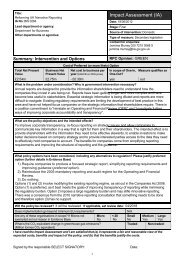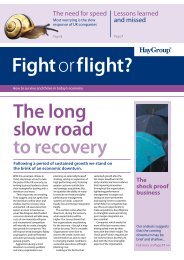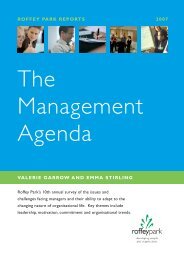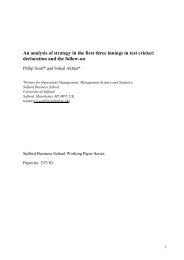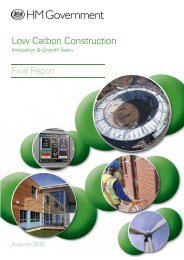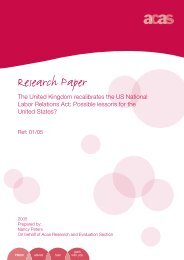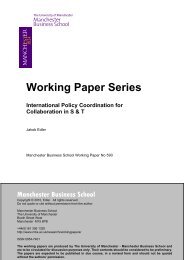Financial Reporting Council A Hampton ... - Dius.gov.uk
Financial Reporting Council A Hampton ... - Dius.gov.uk
Financial Reporting Council A Hampton ... - Dius.gov.uk
You also want an ePaper? Increase the reach of your titles
YUMPU automatically turns print PDFs into web optimized ePapers that Google loves.
<strong>Financial</strong> <strong>Reporting</strong> <strong>Council</strong>This review is one of a series of reviews of regulatory bodies focusing on theassessment of regulatory performance against the <strong>Hampton</strong> principles and Macrorycharacteristics of effective inspection and enforcement. It was carried out by areview team drawn from the Better Regulation Executive, the Environment Agencyand the Care Quality Commission.Further information about the reviews can be found at:http://www.berr.<strong>gov</strong>.<strong>uk</strong>/whatwedo/bre/inspection-enforcement/page44029.html2
EXECUTIVE SUMMARY AND CONCLUSIONSKey findings fromthe review:The review team found that the <strong>Financial</strong> <strong>Reporting</strong><strong>Council</strong> (FRC) demonstrated a very high level ofcompliance with <strong>Hampton</strong> criteria across most areas of itsactivities. The review team also found that the FRCadopted a positive approach to better regulation and wasopen to ideas to continually improve the delivery of itsregulatory responsibilities.The balance between stability and economic growth waswell struck, with a very high level of support from themain stakeholder groups.The FRC was found to operate with strong input frompractitioners, supplemented by excellent widerconsultation. However, the review team would suggest theFRC needs to ensure that the volume of consultation takesinto account the potential burden on stakeholders. Thereview team found the FRC was easily accessible to mainstakeholders on an ongoing basis.The flexible 'soft law' approach to raising standards ofcorporate <strong>gov</strong>ernance in listed companies was found to beworld-class.3
INTRODUCTIONIntroductorybackgroundinformation aboutthe regulator:The FRC was established in 1990, following therecommendation of the Dearing Report, to promote goodfinancial reporting through its two subsidiaries - theAccounting Standards Board (ASB) and the <strong>Financial</strong><strong>Reporting</strong> Review Panel (FRRP).The FRC became the ‘guardian’ of the Combined Code ofcorporate <strong>gov</strong>ernance in the late 1990s.The FRC’s role and remit was greatly expanded in 2004 toinclude setting auditing standards, oversight of theregulation of the auditing and accountancy professions andprofessional discipline in public interest cases.Finally, the FRC took on the responsibility for settingactuarial standards and oversight of the regulation of theactuarial profession in 2006 and professional discipline inpublic interest cases.The legislationestablishing theregulator:The regulator’sstatutory remit orobjectives:The <strong>Financial</strong> <strong>Reporting</strong> <strong>Council</strong>’s functions andresponsibilities derive from a number of sources. A numberof statutory powers have been delegated directly to itsrelevant Operating Bodies. Some of its functions aresupported by statutory obligations on other parties to meetits requirements and/or participate in arrangementsprovided by the FRC. Some of its functions have no statutorybacking but derive their authority from widespread supportfrom, and voluntary arrangements with, its stakeholders.The FRC has an overall aim to promote confidence incorporate reporting and <strong>gov</strong>ernance, in pursuit of theoutcomes defined in the FRC’s published regulatory strategy(April 2009):Corporate <strong>gov</strong>ernance – UK companies with a primarylisting in the UK are led in a way which facilitatesentrepreneurial success and the management of risk.Corporate reporting – Corporate reports containinformation which is relevant, reliable, understandable andcomparable, and useful for decision-making, includingstewardship decisions.Auditing and related services – Users of audit reports canplace a high degree of reliance on the audit opinion,including whether financial statements show a true and fairview, and users of audit-related services can place anappropriate degree of reliance on the reports provided.5
Actuarial practice – Users of actuarial information can placea high degree of reliance on its relevance, transparency ofassumptions, completeness and comprehensibility.Professionalism of accountants and actuaries – Clients andemployers of professionally qualified accountants andactuaries and of accountancy and actuarial firms can rely onthem to act with integrity and competence, having regardto the public interest.The regulator’sbudget:Number of staff(includingbreakdown of policyand frontline staff):The sectors andnumber ofbusinesses regulatedeither directly orindirectly:The FRC budget for 2009/10 is £19.7 million. It receives £2million grant-in-aid funding from BIS and external fundingvia an annual levy from preparers of accounts and from thefinancial reporting professional bodies.In addition to both paid and unpaid Board members, the FRChas a total of 95 employees:Professional: 72 (Full Time 54 and Part Time 18)Administration:23 (Full Time 17 and Part Time 6)FRC standards and requirements impact on about 3.5millionUK companies. The FRC focuses its regulatory activity, inparticular, on entities in which there is a public interest,including approximately 3000 publicly traded companies andthe largest private companies. This includes some of thelarger bodies in the UK. Additionally, it regulates therecognised supervisory bodies which represent around220,000 professional accountants and 4,500 actuaries.Its major stakeholders are recognised as: professional bodies(accountancy and actuarial), industry bodies such as CBI orthe 100 Group – Finance Directors from FTSE 100 companies.Other stakeholders include the major audit firms.6
THE HAMPTON VISION“Both the <strong>Hampton</strong> and Macrory reports are concerned with effective regulation –achieving regulatory outcomes in a way that minimises the burdens imposed onbusiness. Key to this is the notion that regulators should be risk-based andproportionate in their decision-making, transparent and accountable for theiractions and should recognise their role in encouraging economic progress.”Any findingsrelevant to whetherthe review teambelieves theregulator is riskbased:The FRC has embedded risk analysis within its systems wellto guide and prioritise its work in a range of ways:Strategically, its risk tolerance is broadly identified in itsacceptance that failure will happen: its “non-zero failureregime”. However, this does not specify what scale offailure is acceptable, nor how this will be measured.Its approach to setting priorities in the Annual Plan isunderpinned by a simple assessment of: “the risk toachievement of the outcomes and other elements” in theStrategic Framework.The risk assessment identifies the extent to which theoutcome is currently achieved alongside the “downside” and“upside” of risk materialisation. This builds into the cultureof the organisation a breadth of vision accepting a range ofoutcomes are possible, not all of which will be detrimental.The simplicity makes the method easy to adopt andunderstand. It is believed to be an element of good practice.However, focusing on the outcomes in the strategicframework narrows the organisational view. Where thebeneficiaries of the outcomes are stated, they are all fairlyindustry-focused (UK companies with a primary listing, usersof actuarial information, clients and employers etc). As aresult, the risk analysis is fairly industry focused andpotentially quite insular.If the risk assessment were to look at the impact on, oroutcomes for, individuals and communities (the public), theFRC risk tolerance (acceptable and unacceptable failure)could be described in that way. The “downside” and“upside” views could then be annotated to identify howacceptable (or not) those impacts/outcomes may be.In this way, a range of transparency and accountabilitybenefits could be achieved: communication with the publicwould be facilitated; accountability for grant-in-aid fundingwould be strengthened; opportunities to identify unintended7
consequences would be boosted; the likelihood and impactof ‘regulatory capture’ would be reduced; the recognition ofthe role of the FRC within society would be strengthenedand the FRC would be in a leading position to encourageindustry to consider sustainable development in their work.This may make it possible for the FRC core belief in “wealthcreation” to broaden, accepting that ‘wealth’ is not justfinancial. The UK Government's Common SustainabilityPrinciples may provide a useful framework for this broaderconsideration of impacts/outcomes.(http://www.defra.<strong>gov</strong>.<strong>uk</strong>/sustainable/<strong>gov</strong>ernment/what/principles.htm)Tactically, the FRC <strong>gov</strong>ernance arrangements require theOperating Bodies to keep under review any emerging risks orother matters which could affect those aspects ofconfidence in corporate reporting and <strong>gov</strong>ernance which fallwithin their remits. This builds reactive alertness to bigmarket issues into operating systems and ensuresengagement with market participants at this stage. The FRCshares some operating risks by working with partners whereit can to achieve its objectives.Additionally, the annual plan identifies certain areas of riskas specific topics to target in the inspection process “havingparticular regard during our inspection work in 2009/10 toaudit issues relating to going concern, fair value accountingestimates and disclosures and the impairment of assetsincluding goodwill and other intangibles”.Operationally, its effort is expended where it sees most riskto achieving its outcomes e.g. its monitoring activities areheavier for the big accounting organisations and lighter forthe smaller ones.In particular, the Audit Inspection Unit’s (AIU) risk model isnoted as an exceptional tool for analysis which enables thetargeting of inspections.Any findingsrelevant to whetherthe regulator istransparent andaccountable:The majority of feedback from stakeholders is that the FRCtakes huge steps to help them shape its regulatoryactivities. They commented that people at the FRC areusually easy to access. They also said that good feedbackwas provided on consultation responses andreasoned arguments were published on the FRC website.Staff were said to be flexible around the process and werehappy to give early informal feedback.There was strong feedback that the website was easy to8
navigate for those familiar with the FRC systems but moredifficult if you were less familiar with the industry/FRC. Onthis latter point, it was noted that the work of the FRCwould be clearer to those stakeholders less familiar with itswork if its structure were presented in plain English.The FRC has recently moved from just publishing an annualoverview of the work of the AIU to publishing reports onindividual firms which has been welcomed by stakeholders.Communication around sanctions and enforcement activity isfelt to be appropriate, effective and well directed.The review team did note, however, that stakeholders werefairly industry-focused and engagement with the public wasunderstood by FRC to be unachievable. Considerable effortshad been made to engage with small business and investorsbut the considerable challenges of this had not beenovercome.Transparency and accountability with respect to outputs is aparticular challenge for the FRC. The arm’s length approachto delivery, which is positive in many ways, makestransparency and accountability difficult to measure, defineand communicate. The review team recommend that theFRC revisits this important area.Any findingsrelevant to whetherthe regulatorencourageseconomic progress:The regulatory activities of the FRC have strong links to theUK’s economic progress and its regulatory activities arebroadly aligned with this outcome. The FRC demonstrated akeen awareness of its role and remit with respect tofacilitating sustainable economic progress through promotingconfidence in corporate <strong>gov</strong>ernance and reporting.The FRC has sought to ensure that its regulatory activitiesprovide suitable support for business and industry, balancingthe burden of regulation against its responsibilities to ensureappropriate standards of <strong>gov</strong>ernance and reporting.There is strong awareness among staff of the potentialeconomic impacts of its activities, particularly with respectto corporate <strong>gov</strong>ernance/reporting and auditing/actuarialstandards.The review team identified the development of ‘TheCombined Code on Corporate Governance’ as a goodexample of encouraging economic progress. This code is nonmandatorybut operates on a ‘comply or explain’ basis. Anumber of stakeholders highlighted the importance of thiscode in ensuring good corporate responsibility toshareholders and its knock-on benefit for economic progress.9
Development OpportunitiesThe FRC expressed an aspiration to review further theopportunities to include wider values which may include theGovernment’s Sustainable Development Principles. This iswelcomed and supported by the review team.10
DESIGN OF REGULATIONS<strong>Hampton</strong> Principles“All regulations should be written so that they are easily understood, easilyimplemented, and easily enforced, and all parties should be consulted when theyare being drafted.”“When new policies are being developed, explicit consideration should be given tohow they can be enforced using existing systems and data to minimise theadministrative burden imposed.”Key findings onDesign ofRegulations:The review team found that stakeholders were at the heartof the FRC’s design of its regulations. The principles-basedapproach taken with the Combined Code is a particularlystrong example.The FRC could develop this approach by continuing itsefforts to broaden its stakeholder base and reviewing itsapproach to evaluating the costs and benefits of itsproposals.Backgroundinformation such asthe regulator’s rolein developingregulations:Responsibility for the Companies Act and associatedsecondary legislation lies with BIS.The FRC's role is to promote high standards of corporate<strong>gov</strong>ernance, which it does through the Combined Code,although it does not monitor or enforce its implementationdirectly.The FRC also sets standards for auditing and actuarialpractice and for specific aspects of financial accounting. Asthe UK is seeking convergence of standards internationally,the FRC has a key role in influencing international bodies,such as the International Accounting Standards Board.Review findings:The extent to whichthe review teambelieves theregulator is actingin line with the<strong>Hampton</strong> principles:The FRC believes the flexible 'soft law' approach remainsthe most appropriate way of raising standards of corporate<strong>gov</strong>ernance in listed companies. The review team foundthat all stakeholders continue strongly to support theprinciples-based approach of the Code and the flexibilityprovided by "comply or explain". The FRC's approach isthat responsibility for achievement of the standards restswith the decision-makers and stakeholders said they clearlyunderstood it was not a "comply or else" approach.Whilst all stakeholders wanted the approach to remain,11
ADVICE AND GUIDANCE<strong>Hampton</strong> principle“Regulators should provide authoritative, accessible advice easily and cheaply”Key findings onAdvice andGuidance:Backgroundinformation such asthe means by whichthe regulatorprovides advice andguidance:Review findings:The extent to whichthe review teambelieves theregulator is actingin line with the<strong>Hampton</strong> principle:The review team found that all advice and guidance wasjointly developed with stakeholders and was freely availableon the FRC’s website.The FRC has maximised use of its website to promote itsguidance and advice. It is easily searchable for stakeholdersfamiliar with the FRC’s work and contains all key documents.Stakeholders commented that they were involved in thedevelopment of the advice and that the focus was on makingit as easy to understand as possible. Where changes takeplace, the FRC make every effort to pinpoint the changes andgive guidance appropriate to firm size and sector. Forexample, when the audit standards were re-written, the FRChighlighted the text for UK changes and set out workedexamples for application to smaller entities.The speed and effectiveness with which the FRC broughttogether stakeholders to develop jointly and communicatetemporary guidance for going concern and liquidity risk in theperiod of the financial crisis has been highlighted asexcellent practice.13
DATA REQUESTS<strong>Hampton</strong> principle“Businesses should not have to give unnecessary information or give the samepiece of information twice.”Key findings on DataRequests:The nature and style of regulation undertaken by the FRCrequires only occasional data requests from stakeholdersbeyond public data to support key facts publications. Otherdata requests are limited to exceptions, risk-based auditsand investigations associated with complaints.Stakeholders appear to value highly the low burdenassociated with this approach.Backgroundinformation such asthe data required bythe regulator; themeans by whichbusiness can returndata etc:Review findings:The extent to whichthe review teambelieves theregulator is actingin line with the<strong>Hampton</strong> principle:The mode of regulation operated by the FRC encourages andfacilitates a high degree of self-monitoring and selfreportingagainst best practice criteria and guidance. TheFRC oversees the regulatory activities of the professionalaccountancy and actuarial bodies. These bodies regulatetheir members. The FRC takes a risk-based auditing andinspection role and market entry system. Data requests forthese activities are targeted and stakeholders felt theywere relevant to these activities.The review team considered the FRC’s approach to datarequests to be in line with <strong>Hampton</strong> principles for themajority of its activities. As an exception, the team didnote that the relationship with the actuarial profession wassettling down. As monitoring the actuarial profession is anew area, the review team would suggest that the FRCreviews this area to ensure consistency with other boards.14
INSPECTIONS<strong>Hampton</strong> principle“No inspection should take place without a reason.”Key findings onInspections:Stakeholders were generally supportive of FRC’s monitoringand inspection processes. Unanimously, they said theywould rather have good regulation than none.Inspections were targeted and proportionate according torisk. However, the overall scale of individual inspections insome cases was questioned.The FRC works hard to ensure its findings are evidencebased,but this means the investigation process is tenaciousand the threshold for reporting is quite high. As a result,sometimes messages can be delayed or buried. However,reports are welcomed as useful documents.Any relevantbackgroundinformation such asthe number ofinspections and thenumber ofbusinessesinspected; theregulator’s riskmodel etcThe FRC promotes high standards of corporate <strong>gov</strong>ernancethrough the Combined Code, but does not monitor orenforce its implementation by individual boards; setsstandards for auditing and actuarial practice and for specificaspects of financial accounting; and monitors and enforcesaccounting and auditing standards for listed and other majorpublic interest entities.Accountancy regulation is far more developed than actuarialregulation. The nature of the regulated entity is alsodifferent: FRC regulates accountancy firms, but individualactuaries.It was felt that the objectives of inspections could beclearer: were they intended to prove fitness to practice orto improve quality of auditing or both? Clarity here wouldimprove clarity over the form of inspection.FRC’s inspection processes are commended for beginningwith an initial assessment of publicly available data on acompany.Audit Inspection Unit (AIU)The Audit Inspection Unit, part of the Professional OversightBoard (POB), is responsible for monitoring the audits of alllisted and other major public interest entities. As a result,15
the AIU focuses on the largest audit firms in the UK.The AIU carries out full scope inspections involving reviewsof both firm-wide procedures and a sample of individualaudits. The statutory basis for the AIU inspectionarrangements is set out in the Companies Act 2006.The AIU inspection process operates through an electronicAudit Management System. All records are electronic andpaper-based files are not maintained. The inspectionprocess includes a filtering mechanism whereby satisfactoryresponses to items on an initial query list means that thematter is not taken forward to the second stage andtherefore no formal written response is required from thefirm. However, stakeholders were concerned that theprocess did not adequately prioritise the queries or focus onthe important points.The AIU has about 20 staff and maintains a significantpresence in the largest auditing firms (PwC, KPMG etc)throughout the year. The inspection is a lengthy processwhich can take some 18 months to resolve. AIU staff reviewapprox 5% of the eligible annual audit assignments for eachfirm. For example, for one firm, for the year end 07/08, 16out of a total of 300 individual audits were inspected by theAIU before December 08. Between December 08 andFebruary 09 the “firm-wide” systems audit was undertaken.The private annual inspection report was drafted Februaryto June 09 and the public report drafted June to November09.The risk analysis supporting the targeting of AIU inspectionsis highly commended.Stakeholders suggested that inspections could bestreamlined if they were to focus on systems and processes,rather than “second guessing” individual decisions made onaudit files. This is likely to be difficult to implement by FRCwhen individual audit decisions have huge impact. Inaddition, it would contradict the ‘outcomes focus’ ofmodern regulation.The reports were seen as good and the contents werehelpful: they “cover all the bases but are only partlyregulatory”. The latter comment reflects one stakeholder’sfeeling that the scope of inspections had expanded beyondthe regulatory remit.Professional Oversight Board (POB)Primary responsibility for the audit inspection of the smaller16
audit firms is mainly undertaken through the recognisedsupervisory bodies. More explicit partnership working withthese bodies may help to reinforce this link and bridge apotential gap in regulation between public interest firmsand individual professionals.The POB monitors the work of the recognised supervisorybodies with whom it works to uphold standards. Its annualinspection lasts two weeks. Reports from 07/08 activity hadbeen received in November 09. In the meantime, the 08/09inspections had been undertaken so the opportunity toimprove had been hampered.One stakeholder recognised that strategic objectivessometimes took time to be reflected in inspection practice:strategically, market entry was being promoted by asuggestion that large companies may benefit from splittingtheir audit among different audit firms; operationally, afirm had been criticised for doing exactly that.<strong>Financial</strong> <strong>Reporting</strong> Review Panel (FRRP)FRRP inspections are also targeted primarily on the basis ofrisk assessment. Annual reports and accounts are selectedfrom across the full range of companies within the Panel’sremit and are also selected for review on the basis ofcompany specific factors and complaints. Reviews focus onspecific sectors which have been identified through aprocess which involves consultation with the FSA and anelement of stakeholder engagement. During 2009/10 theFRRP inspected about 300 of the 3m potentially eligiblebodies. The FRRP has access to those parts of the AIU riskanalysis system which are publicly available, though webelieve that the FRRP could consider further developing itsrisk analysis system on the AIU lines.Review findings:The extent to whichthe review teambelieves theregulator is actingin line with the<strong>Hampton</strong> principle:Inspections are clearly targeted and proportionate,; the AIUrisk model is particularly impressive. Extensive use ofpublicly available information was also seen as goodpractice. However, the scale of the inspections of largeaudit firms has been questioned and the length of thereporting cycles generally seem to be very long (althoughrecent improvements in reporting have been welcomed).17
SANCTIONS<strong>Hampton</strong> & Macrory principles“The few businesses that persistently break regulations should be identifiedquickly, and face proportionate and meaningful sanctions.”“Regulators should be transparent in the way in which they apply and determineadministrative penalties.”“Regulators should avoid perverse incentives that might influence the choice ofsanctioning response.”“Regulators should follow up enforcement actions where appropriate.”Key findings onSanctions:The FRC’s functions and responsibilities derive from anumber of sources. A number of statutory powers have beendelegated directly to the relevant Operating Bodies. Someof its functions are supported by statutory obligations onother parties to meet its requirements and/or participate inarrangements provided by the FRC – with associatedsanctions. Other functions have no statutory backing butderive their authority from widespread support from, andvoluntary arrangements with, stakeholders.The interventions relate to compliance with accountingstandards (FRRP), the recognition of professional bodies forthe purpose of audit (POB), the monitoring of audit quality(POB/AIU) and professional discipline (Accountancy andActuarial Discipline Board).The FRRP interventions ladder provides an excellent rangeof interventions which builds well to higher impact options.However, sanctions in other Boards provide high levelresponses: a “nuclear option”. The review team suggeststhat the FRC explore ways to broaden the range of FRCresponses and publicly reinforce messages about how FRCresponses work alongside those of the supervisory bodies.Backgroundinformation such asa summary ofsanctions availableto the regulator andany data onsanctions imposed<strong>Financial</strong> <strong>Reporting</strong> Review Panel (FRRP)The FRRP reviews accounts for compliance with the law andaccounting standards. The Panel focuses on the annualaccounts of public and large private companies and keepsunder review interim and final reports of certain otherlisted issuers. It enquires into cases where it appears thatthe rules have not been followed - in the words of the18
y the regulator:Companies Act ‘where it appears to the Panel that there is,or may be, a question whether accounts comply with therequirements of this Act’.Where there may be a case to answer, the FRRP Chairappoints a group to conduct the enquiry, normally made upof five members including the Chair and the Deputy Chair.Other members are chosen from the Panel to provide abalance of experience relevant to the enquiry whileavoiding any potential conflicts of interest. Members of thePanel outside the group are not normally involved and thegroup’s exchanges with the company are confidential.The group puts its concerns to the directors incorrespondence and at meetings. The Panel encouragesdirectors to consult their auditors, to involve their auditcommittee and to take any other advice they feel theyneed. The process is informal but is intended to combineefficiency with fairness. As defective accounts couldmislead the public, the procedures need to allow for speedyrectification. The group aims to reach agreement with thedirectors of the company by persuasion. If the group issatisfied by the company’s explanations, the case is closedand the fact that an enquiry was made remains confidential.Where the directors agree to take remedial action the Panelissues a press notice. The Panel does not comment on ordiscuss its conclusions further. The review team did not askhow issues included in reports were followed up to ensurethat system changes were made to prevent recurrence.The Companies Act 2006 provides for the FRRP, wherenecessary, to apply for a court order requiring the revisionof non-compliant accounts. This power has not been used.Professional Oversight Board (POB)The POB is responsible for independent oversight of theregulation of the auditing profession by the recognisedsupervisory and qualifying bodies. It discharges thestatutory responsibilities delegated by the Secretary ofState for authorising professional accountancy bodies to actas supervisory bodies and/or to offer a recognisedprofessional qualification in relation to statutory audit.The POB has the “nuclear option” of de-recognising aprofessional body, but in practice discharges theseresponsibilities through inspection and dialogueThe Audit Inspection Unit (AIU) of the POB monitors thequality of the auditing function in relation to listed19
companies and any other entity in whose financial conditionthere is a major public interest. Its “sanctions” are topublicise shortcomings in the quality of auditing and, wherenecessary, individual audit firms.The AIU issues individual public reports on the findings of itsinspections of the Big 4 Firms and the other major firmsinspected in that year. It also issues an overview report foreach year which outlines key overall findings from itsinspection work. In addition, it issues reports on individualaudits reviewed by the AIU to the relevant audit firms witha view to them being made available by the firms to thedirectors of the audit clients concerned.Stakeholders praised AIU report publications which hadrecently improved and were now more informative.Accountancy and Actuarial Discipline Board (AADB)The AADB is an independent body which investigates theconduct of members, or member firms, of the professionalaccountancy bodies and the actuarial professional bodies. Itis responsible for taking disciplinary action in public interestcases - matters which raise, or appear to raise, importantissues affecting the public interest. The arrangements forindependent investigation and/or disciplinary hearingsprovided by the AADB amount to “appropriate independentarrangements” within the terms of the Companies Act 2006.In order to achieve recognised supervisory body status asupervisory body must participate in these arrangements.The bye laws of the actuarial and accountancy professionalbodies provide that their members are subject to the AADBactuarial scheme. These provisions are supported by theMemorandum of Understanding between the FRC and theprofessions.All other disciplinary matters are dealt with via thedisciplinary structures of the recognised supervisory bodiesor other participants in the AADB schemes.Individuals and firms subject to the disciplinaryarrangements are required to cooperate with AADBinvestigations and proceedings, e.g. by providing documentsand other information, attending interviews and givingevidence to the Disciplinary Tribunal. Tribunals are held inpublic.If a Tribunal upholds a complaint, it can impose a wide20
ange of sanctions, including:• Reprimand or severe reprimand• Unlimited Fine• Waiver or repayment of client fees• Withdrawal of practising certificate, registration,authorisation or licence• Expulsion or exclusion from Membership for arecommended period, up to 5 years.Review findings:The extent to whichthe review teambelieves theregulator is actingin line with the<strong>Hampton</strong> principlesand Macrorycharacteristics:Stakeholders reported being kept well informed about AADBcases and prospective investigations but were not aware ofthe detail of allegations or what happened if cases weredropped.Given the non-zero failure regime, the level of applicationof sanctions is interesting. This may be because limitedoptions are available to FRC, because they only have theoptions as set out in the Scheme.It is recommended that the FRC review the possibility ofusing or publicising a broader range of sanctions across theirremit and in partnership with recognised supervisory bodies(RSBs). This may involve investigation of gaining Macrorypowers.21
FOCUS ON OUTCOMES<strong>Hampton</strong> principle“Regulators should measure outcomes and not just outputs.”Key findings onFocus on Outcomes:The primary role of the FRC, promoting confidence incorporate reporting and <strong>gov</strong>ernance, is intuitively alignedwith the needs of the business sector.The FRC published its ‘Regulatory Strategy: Our Role andApproach’ in April 2009. This document clearly sets out theregulator’s aims and its six key strategic outcomes, whichcover:1. Corporate <strong>gov</strong>ernance2. Corporate reporting3. Auditing and related services4. Actuarial practice5. Professionalism of accounts and actuaries6. FRC effectivenessBased on interviews with stakeholders it was apparent thatthe FRC had consulted widely on these objectives andsecured the broad support of its stakeholders through goodcommunications.The real challenge for the FRC in this respect is its ability tomeasure outcomes and to do this with transparency andaccountability. Although both the FRC and its stakeholdersfeel positive, it is difficult for the FRC to develop reassuringmetrics for outcomes beyond the negative proving thepositive. The annual use of a stakeholder survey is oneuseful metric but is very much based on perceptions ratherthan actual measurable performance. It was also noted thatthis process is currently only focused on specific stakeholdergroups.Development OpportunitiesIt is recommended that the FRC revisits the use of theannual stakeholder survey to ensure:• it enables a representative cross section ofstakeholders• provides a longer term picture of trends inconfidence• provides a basis for outcomes metrics22
Backgroundinformation such asthe regulator’s keyobjectives:The primary objective of the FRC is to promote confidencein corporate reporting and <strong>gov</strong>ernance for the benefit ofeconomic progress. This overarching objective isunderpinned by the six key strategic outcomes highlightedabove.The FRC Annual Report 2008/09 provides a comprehensivestatement of its objectives, outputs and perceivedperformance. The Annual Report is further supported by agood range of published documentation under each of its sixkey strategic outcomes.Examples of goodpractice:The FRC largely provides oversight, direction and nonmandatoryguidance/codes. The use of Operating Bodiesand delegation to professional bodies is a positive modelwhich appears to work well, liberating responsibility andreducing regulatory burden. This model, with its highdegree of self regulation/self monitoring, requires the FRCto maintain ongoing engagement with the businesscommunity.The use of Operating Bodies, Professional Bodies and thewide, but appropriate, use of consultation is an example ofgood regulatory practice. The interview process withstakeholders did, however, highlight some tensions andfrustrations. The accountability of the FRC is less clear thanmany comparable regulators which have clear, measurable,outcomes for respective regulated sectors. The apparentlack of accountability for outcomes and the perceiveddelegation of accountability without authority/responsibilitywas highlighted by some stakeholders.The documentation produced by the FRC with respect tooutcomes is comprehensive and well written. The onlyconcern with these outcomes is the lack of metrics whichwould provide a more objective assessment of delivery thanthe current model. It is clear that developing such metricswould be challenging and in itself may increase regulatoryburden through the need for additional data collection.23
The extent to whichthe review teambelieves theregulator is actingin line with the<strong>Hampton</strong> principle:Stakeholders confirmed that they were aware of the FRC’saims and objectives and demonstrated positive support forthese. The FRC demonstrated good alignment with <strong>Hampton</strong>principles with respect to the delivery of its outcomes.The <strong>Hampton</strong> principles were not explicitly highlighted ineither the documentation or the interviews held with staff.It appeared that the principles were implicit within themode of regulation adopted by the FRC. It was not alwaysentirely clear if the implicit nature of the <strong>Hampton</strong>principles within the mode of regulation was by design ormore a fortunate by-product of the FRC setup.24
Appendix 1: reviewteam membershipChad Woodward is an Assistant Director in the BetterRegulation Executive in the Department for Business,Innovation and Skills. His background is in policy, projectmanagement, sales and marketing within the public andprivate sectors.Trevor Bishop is Head of Water Resources Policy for theEnvironment Agency. Trevor’s background is in waterindustry management with a specific emphasis on nationalwater policy since joining the Environment Agency in 2005.Tania Clarke has a background in management of ‘messy’change in the civil service, regulation, farming, forestry andhealth. At the Care Quality Commission she leads on thedevelopment of methods and processes to analyseregulatory risk and enable collaborative working. Taniajoined the Commission in November 2004 to enableimplementation of the 'Concordat between bodiesinspecting, regulating and auditing healthcare'. This was anagreement between 21 partner organisations to deliver jointimplementation of the <strong>Hampton</strong> principles.25
Better Regulation ExecutiveDepartment for Business, Innovation and Skills3rd Floor1 Victoria StreetLondon SW1H 0ETWebsite: www.bis.<strong>gov</strong>.<strong>uk</strong>/breURN: 10/690© Crown copyright 2010The text in this document may be reproduced free of charge in any format or mediawithout requiring specific permission. This is subject to material not being used in aderogatory manner or in a misleading context. The source of the material must beacknowledged as Crown copyright and the title of the document must be included whenbeing reproduced as part of another publication or service.26




